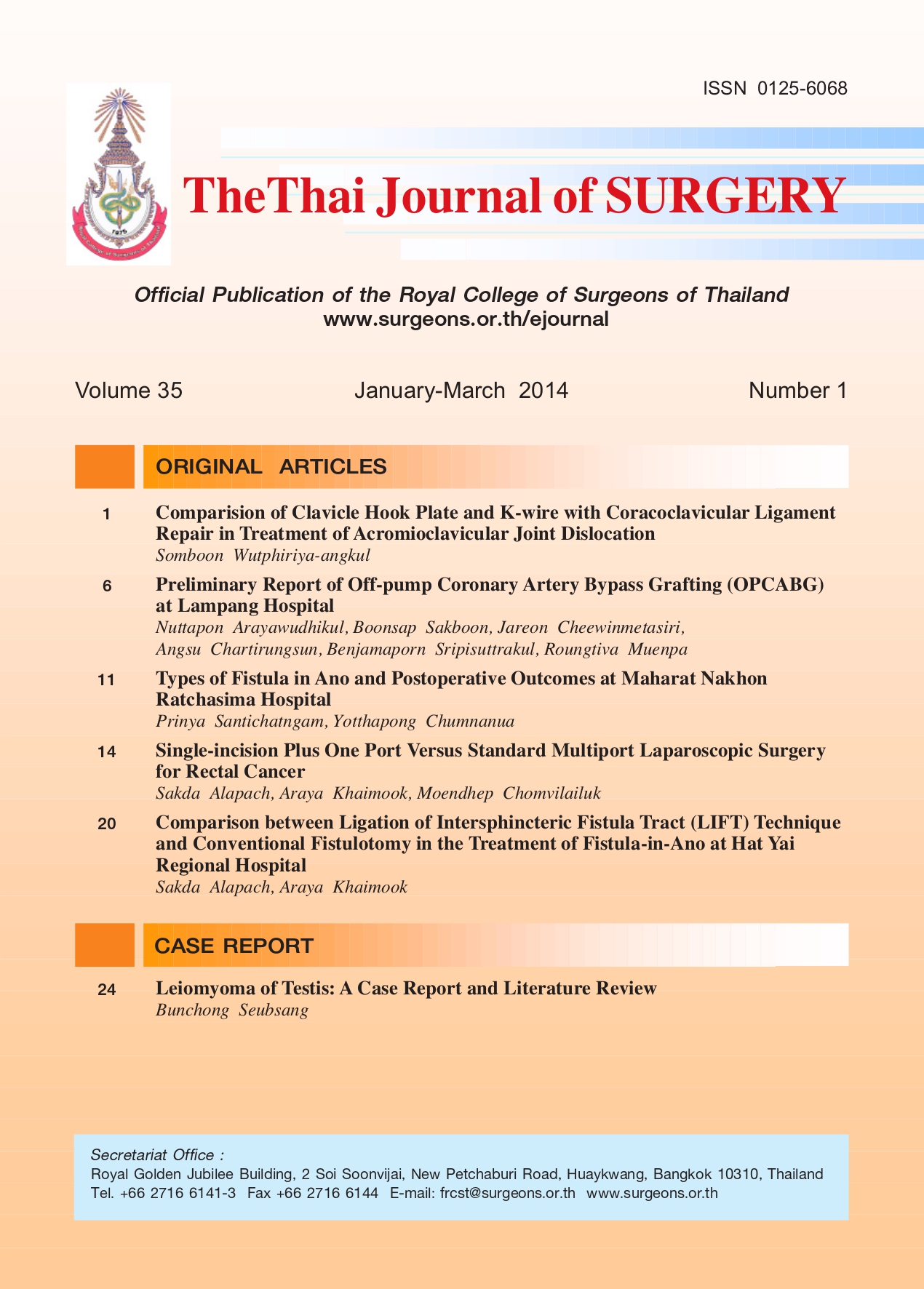Preliminary Report of Off-Pump Coronary Artery Bypass Grafting (OPCABG) at Lampang Hospital
Keywords:
Myocardial revascularization, Coronary artery bypass grafting, Off-pump coronary artery bypass graftingAbstract
Objective: Conventional coronary artery bypass grafting (CABG) is the standard treatment for patients with coronary artery heart disease. However, its major and life threatening complications include stroke and renal dysfunction. Off-pump coronary bypass grafting (OPCABG), by avoiding cardiopulmonary bypass, may reduce these complications.
Patients and Methods: We retrospectively reviewed the records of 125 consecutive patients (male 59 cases, female 66 cases) who underwent elective OPCABG from April 2011 through September 2013.The mean age (sd) was 63.8 ± 8.6 years. Left main disease was present in 24.8%. Preoperative renal insufficiency (Cr > 2.5 mg/dl) was seen in 20% of cases while previous stroke was found in 2.4%. Mean Euroscore (sd) was 6.65 ± 2.9. Results: Mean graft per patient (sd) was 3.4 ± 1.1. The internal mammary artery was used in 84.8% of cases. Endarterectomy was performed in 11 patients (9.1%). Total arterial grafting was performed in 20 patients (16.0%). Conversion to on-pump technique occurred in 2 cases (1.6%); 2 patients died within 30 days (1.6%); and late deaths occurred in 4 cases (3.2%). Renal dysfunction requiring dialysis occurred in 1 (0.79%), and re-exploration for bleeding occurred in 2 cases (1.6%). There were no stroke events and no sternal wound infections. The mean follow-up time (sd) was 16.4 ± 11.03 months.
Conclusions: Early results of OPCABG at Lampang hospital were promising, with no mortality and low morbidity.
References
2. The First National Adult Cardiac Surgical Database Report. The Society of Thoracic Surgeons of Thailand, 2011.
3. Ruengsakulrach P. Off-pump all arterial coronary artery bypass grafting. Bangkok Med J 2011; 32-47.
4. Kirklin JK, Westby S, Blackstone EH, Kirklin JW, Chenoweth DE, Pacifico AD. Complements and the damaging effect of cardiopulmonary bypass. J Thorac Cardiovasc Surg 1983:86:845-57
5. Engelman DT, Cohn LH, Rizzo RJ. Incidence and predictors of TIAs and strokes following coronary artery bypass grafting: report and collective review. Heart Surg Forum 1999;2:242-5.
6. Lytle BW, Loop FD, Cosgrove DM, Ratliff NB, Easley K, Taylor PC. Long-term (5-12 years) serial studies of internal mammary artery and saphenous vein coronary bypass grafts. J Thorac Cardiovasc Surg 1985;89:248-58.
7. Fitzgibbon GM, Kafka HP, Leach AJ, Keon WJ, Hooper GD, Burton JR. Coronary bypass graft fate and patient outcome: angiographic follow-up of 5,065 grafts related to survival and reoperation in 1,388 patients during 25 years. J Am Coll Cardiol 1996;28:616-26.
8. Chaiyaroj S, Viengteeravat S, Bhumarangura W, Khajarern S, Leelayana P, Puruntrapiban B. Techniques and results of off-pump coronary artery bypass grafting using homemade intracoronary shunt. J Med Assoc Thai 2006;89:
9. Larmann J, Theilmeier G. Inflammatory response to cardiac surgery: cardiopulmonary bypass versus non-cardiopulmonary bypass surgery. Best Pract Res Clin Anesthesiol 2004; 18:425-38.
10. Carrico CJ, The elusive pathophysiology of the multiple organ failure syndrome. Ann Surg 1993;218:109-10.
11. Beal AL, Cerra FB. Multiple organ failure syndrome in the 1990s. Systemic inflammatory response and organ dysfunction. JAMA 1994;271:226-33.
12. Arom KV, Flavin TF, Emery RW, Kshettry VR, Petersen RJ, Janey PA. Is low ejection fraction safe for off-pump coronary bypass operation? Ann Thorac Surg 2000;70:1021-5.
13. Immaki M, Ishida A, Shimura H, et al. Early results of off-pump coronary artery bypass. Jap J Thoracic Cardiovasc Surg 2005;53:244-50.
14. Hirose H, Amano A, Yoshida S, Takahashi A, Nakano N. Offpump coronary artery bypass: early results. Ann Thorac Cardiovasc Surg 2000;6:110-
15. Puskas J, Cheng D, Knight J, et al. Off-pump versus conventional coronary artery bypass grafting: a metaanalysis and consensus statement from The 2004 ISMICS Consensus Conference. Innovations 2005;1:3-27.
16. Shennib H, Lee AG, Akin J. Safe and effective method of stabilization for coronary artery bypass grafting on beating heart. Ann Thorac Surg 1997;63:998-92.
17. Cheng DC, Bainbridge D, Martin JE, Novick RJ. Does offpump coronary artery bypass reduce mortality, morbidity, and resource utilization when compared with conventional coronary artery bypass? A meta-analysis of randomized trials. Evidence-Based Perioperative Clinical Outcomes Research Group. Anesthesiology 2005;102:188-203.
18. Ascione R, Reeves BC, Rees K, Angelini GD. Effectiveness of coronary artery bypass grafting with or without cardiopulmonary bypass in overweight patients. Circulation 2002; 106:1764-70.
19. Calafiore AM, Di Mauro M, Contini M, et al. Myocardial revascularization with and without cardiopulmonary bypass in multivessel disease: impact of the strategy on early outcome. Ann Thorac Surg 2001;72:456-62.
20. Demaria RG, Carrier M, Fortier S, et al. Reduced mortality and strokes with off-pump coronary bypass grafting surgery in octogenarians. Circulation 2002;106: I5-I10.
21. Sabik JF, Gillinov AM, Blackstone EH, et al. Does off-pump coronary surgery reduce morbidity and mortality? J Thorac Cardiovasc Surg 2002;124:698-707.
22. Kleisli T, Cheng W, Jacobs MJ, et al. In the current era, complete revascularization improves survival after coronary artery bypass surgery. J Thorac Cardiovasc Surg 2005; 129:1283-91.
Downloads
Published
How to Cite
Issue
Section
License
Articles must be contributed solely to The Thai Journal of Surgery and when published become the property of the Royal College of Surgeons of Thailand. The Royal College of Surgeons of Thailand reserves copyright on all published materials and such materials may not be reproduced in any form without the written permission.



